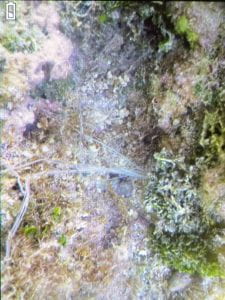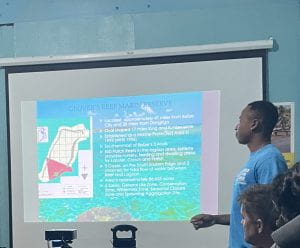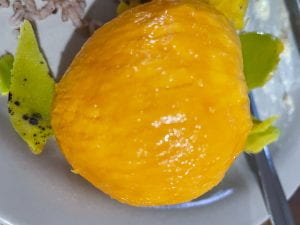Tag Archives: conservation
Final Reflection Blog: An Unbelizeable Adventure!
Throughout this course I have learned and experienced so much in such a short amount of time, and I have definitely walked away with an unshakeable sense of wonder and respect for these two tropical ecosystems. One of the main ideas this course has left me with is in the surprising amount of similarities between these two seemingly separate ecosystems, and how that might relate to their current biodiversity. Both coral reefs and rainforests are shaped by their how they maximize the use of limited resources such as light, nutrients, wave energy, and soil. The variety of complex ways in which these organisms adapt to these conditions is reflected in their unmatched biodiversity.
Some personal connections I made along the way are definitely related to what I studied for my topic lecture: the biogeographic history of the region. Both of the specific ecosystems we visited were highly shaped by the history of geologic processes in the region. Glover’s atoll was created by past volcanic activity, and the limestone sediments that characterize the karstic landscape of the Chiquibul were deposited millions of years ago. Actually, the origin of the calcium carbonate in this limestone is from the many millions of marine shelled creatures that lived there when that area was underwater, so the connections run even deeper! Both areas were also deeply impacted by continental movements, specifically the connection of North and South America 3 million years ago, which separated the oceans and joined the terrestrial organisms, but still both leading to continued diversification.
This course was more difficult in some ways than I expected, but also so much fun! I definitely expected to get lots of bug bites while there, but I certainly did not expect the sheer volume of mosquito, sand mite, and chigger bites I came home with! My least favorite part was probably getting seasick on the first boat ride in, that was pretty miserable. Future TFBs beware, and bring itch cream and Dramamine! But as is true with most field work, there were so many fun moments that made all the uncomfortable parts so so worth it! Some of my many favorite moments include: seeing giant ceiba trees, watching a jaguar feed, eating lionfish ceviche, holding a comb jelly, touring the Caracol Archeological Reserve, and seeing the beloved Mexican burrowing toad! And all of these moments were made even better by the friendships I made with my classmates, which I am very grateful for.
Before I post this final blog, I want to leave it by sharing some of the most important or surprising things I learned on this trip that will stick with me for a long time. The entire guest lecture by Dr. Arevalo was definitely memorable for me, especially in his dedication to the ecology and conservation of the scarlet macaw, and his point that there is only limited impact for ecology research if we do not actively apply it to conservation practices and efforts. I will also always remember our conversations on the health of coral reefs, and how quickly climate change can damage these beautiful places. It was something I was always aware of in the periphery of my mind, but there is something different about firsthand experiencing the incredible diversity of these reefs and then learning how threatened they really are. One final thing I will always remember is seeing and learning about the insane complexity of leafcutter ant colonies! We learned that the characteristics of the ants change as the colony ages and can spread into massive structures that last with a single queen for a max of about 25 years! The fact that such complex eusocial animals have evolved is so insanely cool!
This class and the people I got to know along the way are unforgettable and I had such a great time!
-Phoenix
Day 5: More Taxa Sightings & Reef Conservation
In the morning, we traveled by boat to more marine protected areas to continue our coral health research project and conduct more sea urchin gathering/counting (I discovered that it is very fun to hold sea urchins and not scary at all :D). We also caught our second lionfish of the day! Yay!
I also noticed a beautiful and healthy branching fire coral (millepora alcicornis). It dawned on me that despite a few stag horn corals in the area that it was one of the only branching hard coral left healthy on this reef. I could see fish and sea urchins all around it! It’s so important to our coral reef ecosystem!
I also saw my first star horse-shoe worm (pomatostegus stellatus)! It was bright orange and very sensitive to my water movement, but I finally managed to get a picture! You can tell it’s a star horseshoe worm by it’s U-shaped crown radiole, but it’s hard to see in this picture.
Below is another cool Christmas tree worm!
Later when snorkeling just off of Glover’s Atoll for our optional snorkel, I saw a pufferfish (pictured below) and a stingray with my snorkel buddy Faith. I also spotted a lionfish and alerted the group, but unfortunately we could not catch this invasive species.
I also saw some a new species of worm called spaghetti worms (eupolymnia crassicornis)! They usually live in holes in the sand or in coral and they have long (< 18 inches) thin noodle-like tentacles which help them to catch food! I was surprised to see so many since they usually live on or under the sand which makes them hard to see. If you lightly touch their tentacles it will retract which is so cool to see. I love annelids.
Later that night, we had a guest lecture from the manager of Glover’s Research Station, Rafael. He told us that this was one of the only places in the Caribbean that is dedicated to preserving pristine reefs. There is not commercial fishing in this area, and fishermen willing to break this rule face these thousands of dollars in fines- some can even face jail time. If a large amount of fish that is illegally caught and dead, all the fish will eventually be donated to humanitarian nonprofits such as orphanages. There has only been 4 infractions in 2022 so far. Three people are stationed on Glover’s Atoll which include the manager, ranger, and marine biologist and these people enforce the laws. Since there is limited staff, some times the Coast Guard will also assist when there is trouble. The Glover’s Reef Staff has maintained good relations with the local fishermen and some of these fishermen will report illegal fishing that they see. Rafael told us he saw a shift of thinking towards sustainable fishing for the local people as although fishing is a necessity for providing for their families they also want to preserve their reefs. Glover’s Reef Research Station has assisted the Wild Life Conservation Society in many surveys such as: turtle egg surveys, lobster surveys, stony coral tissue loss disease surveys, and conch surveys.
It’s very cool to see these conservation efforts and I hope I can contribute in any small way! Peace and love from Belize.
~ Maegan
(this is such a beautifully cut mango that I felt needed to be highlighted :p)
Still Can’t Believe It’s Over… (Wrap Up Blog)
Although our EBIO 319 class was clearly dividing into teams Surf and Turf, based on whether we had signed up predominately to go to the reef or to the rainforest, everyone was able to thoroughly enjoy themselves in both environments because there are quite a few similarities between them. The most obvious similarity is that both are hotspots for biodiversity. Both coral reefs and rainforests are (predominately) restricted to the Tropics, and both are highly dependent on water.
Additionally, nutrient input and cycling is critical to the stability and growth of both environments. Corals thrive in oligotrophic environments, and so they are dependent on nutrient-cycling symbionts. Tropical rainforests exist in nutrient-poor soils, and so the plant species are dependent on nutrient cycling.
Another similarity that I noticed is that it is quite difficult to traverse through either of these environments. When snorkeling on the reef, there would sometimes be spots with very little accommodation space and it was difficult to pass through without bumping into the corals. In the rainforest, when we left the trail the vegetation was often very dense. There would be lots of vines hanging down between the trees, and a lot of holes in the ground.
Additionally, you had to be careful moving through both of these environments because there were so many things that could hurt you. On the coral reef, this included anemones, fire coral, some hard corals, sharp shells, and jellies. In the rain forest, this included venomous snakes, acacia thorns, fire ants, and ticks.
I had a really good time during this course. The amount of work that it involved was much more than I expected, but during the course I didn’t worry about it too much. Going into the course, I didn’t really know what to expect about my classmates, but everybody was really cool and we got along really well. The rainforest’s appearance was not really what I expected but I think the reef did look like what I was expecting, probably just because I was more familiar with reefs going in. I was expecting Glover’s Atoll to be paradise, and it truly was.
My favorite part of the course was being able to see cool species up close. There were so many, but highlights included the green turtle, the seahorse, the Queen Angelfish, the tapir, and the scarlet macaws. Another one of my favorite things that we did was going into the caves. These sightings and experiences are things that I will never forget.
I think my least favorite part of the course was the fact that it was so windy during our time at Glover’s because as a result we never did get to go diving on the forereef or at night. My other least favorite part was probably the lionfish dissection because I just don’t like dissecting things in general.
One of the most important things I learned on this trip was that I definitely still want to try and go into marine biology and do real field work. Another thing I learned was that friendships form really quickly when a group of people are all working together on something they’re passionate about. Lastly, I learned that conservation work is really really complicated after hearing presentations from Alex of the Wildlife Conservation Society and Boris of Friends of Conservation. This stuck with me because I’m doing a policy internship this summer at a marine sanctuary, and as a result I’ve gotten a small glimpse of all that conservation actually involves in this particular environment.
Until Next Time, Belize
Scrolling through pictures of both corals reefs and the tropical rainforest, it’s clear that both are incredibly lush environments that host diverse sets of organisms. But through this course, I’ve realized that there are more subtle similarities between the two. In the Chiquibul, we studied how the tropical soils are somehow able to sustain a diverse ecosystem while being incredibly poor in nutrients. These soils are paralleled by the oligotrophic, or nutrient-poor, waters of Glover’s Reef; both inexplicably provide a home for thousands of organisms while seemingly offering no sustenance. However, both of these habitats are characterized by rapid nutrient turnover. For every fish or insect we see, there are millions of others living organisms like microbes that exist outside of human view. The key to both of these habitats’ success seems to be this system of efficient nutrient cycling, which leaves the area nutrient-poor but the animals themselves nutrient-rich.
Perhaps even more importantly, these two ecosystems are tied together by their impending destruction. Both Glover’s Reef and the Chiquibul are faced with problems of illegal extraction and habitat loss for a number of organisms. The biology of deforestation and coral bleaching may act in different ways but the cause is the same: humans. Conservation issues plague ecologists in both areas, as they attempt to battle the overexploitation of natural resources. Poaching and overfishing are one in the same in that they sustain a desperate human population with no other livelihood, while depleting these environments of their incredible diversity.
With that said, I did notice that human intervention in the rainforest seemed much less obvious. Since Las Cuevas was so removed from civilization, the biggest indicators of human presence were camera traps and the occasional logging truck. On the reef, however, we saw a huge amount of marine debris, acting like a red flag for mass consumerism. It’s harder to see our effects on the rainforest in a short amount of time, but the 90 lbs. of Styrofoam and bottle caps serve as a pretty blatant reminder of what we’re doing to the natural world.
Overall, this course has completely surpassed all of my expectations (entirely thanks to Scott and Adrienne and all of their hard work). Ihoped to come out with a better understanding of fieldwork, but I didn’t expect to learn nearly as much as I did about conservation or how to deal with unreliable transportation. My favorite part was probably going through our camera trap photos. After 26 miles of hiking and anticipation, the payoff of that single ocelot picture was fantastic. It really made me appreciate how hard field researchers have to work. And even now that I’m back with air conditioning and wifi, I can’t say that I had a least favorite part of this course (not even the sand flies). With every van we missed and blister we added, I think we learned to be better TFBs, and that’s not an experience I could’ve gotten anywhere else.
In five years, I may have to consult my field notebooks to brush up on specifics, but I’ll definitely remember these three things:
1. Make bold choices, and live by the motto “Screw it, let’s do it!”
2. Field work takes patience and a whole lot of sweat, but it’s worthwhile in the end.
3. Never underestimate the power of a good pair of rubber boots.
I realize that I’m writing my final blog post in the very same seat I occupied two weeks ago to hurriedly write my pre-departure post. It’s incredible how much has changed since the last time I sat here; I’m a little bit tanner and covered in a whole lot more bug bites, but more importantly, I’ve returned with a whole new appreciation for the natural ecosystems I visited. Conservation is a multi-faceted and complex process with no easy solution, but with every bit we learn about the diverse habitats of the tropics, our understanding increases.
In the words of a true Belizean, “You’ve got to see it to Belize it.”
The Professor Who Cried Mosquito

It sure is one thing to learn about conservation, but seeing it in action is a whole other story. And this morning’s experiment was really all about doing conservation. After learning about marine debris, we spent the morning on a task that was part data collection and part beach cleanup. In just an hour, we picked up an incredible 90 pounds of trash. But the real kicker is that the same beach is cleaned every week, so everything we collected today had accumulated in just one week. Talk about mass consumerism.
In the afternoon, we tackled the much-awaited “mangroves of death.” Prepared by horror stories of mosquito clouds in years past, we were ready to sprint through the mangroves, snorkel and all. But our mangrove run turned into a leisurely stroll, as we encountered a total of zero bugs. A classic case of the professor that cried mosquito.
After our safe passage, we said a tearful goodbye to our quadrats with one last coral experiment. We conducted our study on the back reef just beyond the island’s shoreline, where I saw much fewer herbivorous fish than on the patch reefs inside the atoll. The corals in this area seemed much more spread out and covered less area, which might explain the smaller number of fish.
To wrap up, we did our first night snorkel today. The reef is a whole other world at night; instead of seeing brightly colored parrotfish and small damselfish darting among the corals, I found a whole slew of other creatures. Some notable sightings included several huge spiny lobsters, a Nassau grouper, a yellow stingray, and several Caribbean reef squid. However, I did also find what looked like a blue tang surgeonfish (Acanthurus coeruleus); it had the characteristic spine on its caudal fin, but also had thick, vertical white stripes over its blue coloring.
To summarize, this is what I learned today: the ocean is filled with our trash; don’t use Styrofoam; and the reef is pretty damn cool in the dark.
“SNAAAKE!”
For our second to last day at Las Cuevas, we wrapped up our arthropod experiment by collecting all the pitfall traps set along the Maya trail yesterday. The majority of the day was dedicated to data analysis and the presentation of our results; there’s nothing quite like having a poster session in the middle of the rainforest.
We also spent a good part of the day discussing illegal extraction from the Chiquibul and the problems with conservation in Belize. I never fully appreciated the intricacies of conservation biology until today. The Chiquibul’s greatest threat is illegal extraction of plants and animals by Guatemalans from villages along the nearby border. Yet the issue of conservation is much greater than that of sustaining the area’s ecology and incorporates complex economic and political landscapes, as well.
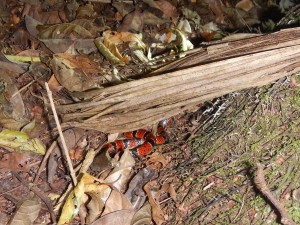
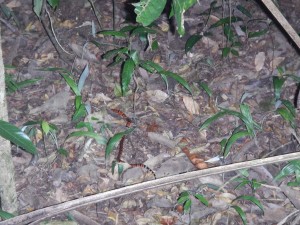
Since our activities were primarily indoors, the day offered few opportunities for reptile sightings. However, I was excited at the prospect of our first night hike—the evening brings out a number of nocturnal species, transforming the Chiquibul into a completely different habitat than it is during the day. We managed to spot all kinds of creepy crawlies, including spiders the size of your face and a giant roach that emitted a sticky white substance. By the end of the hike, I had nearly given up on searching for reptiles in the leaf-litter and under fallen logs. But at the very end of the trail, we approached a sinkhole; as I peered down I heard a shout of “snaaaake!” I looked down to find the distinctive tri-color banded pattern of the Central American coral snake (Micrurus nigrocinctus) all but a foot away from my boot. The snake was small but could clearly be identified as one of the most venomous snakes found in Central America. Just goes to show that you can never stop looking.
Two Days!
As someone who came into Rice knowing exactly what she wanted her major to be, I have been looking for ways to work this course into my curriculum since the beginning. While my certainty in EBIO has never wavered, I am not a place to definitively say what kind of research I want to go into. That’s where EBIO 319 comes in. I expect that this course’s broad nature will give me a more comprehensive view of the field that I will eventually be going into. Do I want to focus on terrestrial or marine systems? Ecology or evolution? What specific system? These are questions that I hope to at least make some progress on. I also expect that I will be underprepared for the trip in some large way. On similar trips, I have found this to be true. I’m not too worried about this; everything works out in the end (and you get great stories!) I love going on trips like this not only because of their educational value, but because of how they bring the participants together. I fully expect that we will find the trials and tribulations of the rainforest and coral atoll material for bonding. I cannot wait to get to know these people better.
The last couple of days have been very hectic for me, as I’m sure they have been for all of my classmates. I think we are all feeling increasing pressure to have everything perfectly in order. Getting proper fins has been a particular struggle for me. I think that I might end up carrying them in my lap on the plane! While there have been many logistical hurdles to clear, I have also been preparing my knowledge of the country. The book, while definitely long, has been a valuable resource in explaining the important biotic and abiotic factors in the region. At the same time, I don’t want to remain too reliant on the book to prepare me. Words can only do so much. I’m prepared to have many of my assumptions be proven wrong upon arrival.
In addition to hopefully providing some clarity on what I want to focus on in my EBIO curriculum, I hope that this course give me a immersive view into an ecosystem. After spending two years learning about ecosystems interactions from afar, I am excited to be right in it for two weeks. I think that this will greatly flesh out my current EBIO knowledge.
On the other hand, I am worried that I’ll get all of the way out there and be completely lost in the myriad of topics that we will be covering. It is possible that the breadth of the course will further my confusion on my specific interests. On the logistical side of things, it is very possible that I will forget something crucial (deodorant? pants?). Ah well, neither of these worries overshadows my overall excitement for the course!
I know that I am going to enjoy this trip. Travel is one of my favorite things to do and when combined with the subject that I love, I know that this will be an experience that will remember even when I have left Rice. A couple of years ago, I went on a scientific/tourist expedition to the Galapagos Island with National Geographic. While I was probably too young to fully appreciate the impact, it definitely peaked my interest in the biological sciences. Later on, I traveled with my high school to Peru for a more service oriented trip. Both trips to Latin America were great experiences. I am looking to continue this trend. In the end, I am most excited to simply be in Belize. I can picture myself waking up for breakfast, not in Martel College but in the rainforest/coral reef. The calmer moments before we leave for the day’s research will likely be what I remember most. Well that and the academic clarity I hope to find. I can’t believe it’s only two days away!








